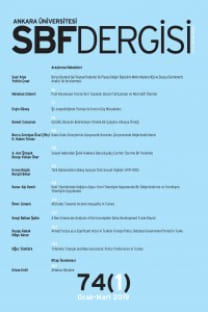Türkiye Ekonomisinin Makro Ekonomik Performansı: 1951-2003 Dönemi İçin Parametrik Olmayan Bir Ölçüm
The Macroeconomic Performance of Turkey's Economy: A Non-Parametric Measurement for 1951-2003 Period
___
- BANKER, R.D. / CONRAD, R.F./ STRAUSS R.P. (1986), "A Comparative Application of DEA and Translog Methods: An Illustrative Study of Hospital Production," Management Science (C. 32): 30-44.
- BANKER, R.D. / MOREY, R.C. (1986), The Use of Categorical Variables in Data Envelopment Analysis," Management Science (C.32): 1613-1627.
- BULUTAY, T. (1995), Employment, Unemployment and Wages in Turkey (Ankara: International Labour Office).
- CARLMFORS, L. / DRIFFELL, J. (1988), "Barganing Structure, Corporatism and Macroeconomic Performance," Economic Policy (C. 6): 13-61.
- CHARNES, A. / COOPER, W.W. (1962), "Programing with Lineer Fractional Functions," Naval Research Logistics Quarterly (C. 9): 3-4.
- CHARNES, A. / COOPER, W.W. / RHODES, E. (1978), "Measuring Efficiency of Decition Making Units," Journal of Operational Research (C. 2): 429-444.
- CHARNES, A. / COOPER, W.W. / RHODES, E. (1979), "Short Communication: Measuring the Efiiciency of Decision Making Units," Journal of Operational Research (C. 3): 339.
- CHERCYE, L. (2001), "Using Data Envelopment Analysis to Assess Macroeconomic Policy perfromance," Applied Economics (C. 33): 407-416.
- CHILINGERIAN, J. / SHERMAN, H.D. (1989), "Evaluating and Marketing Efficiency Physicians Toward Compatitive Advantage," Health Care Strategic Management (C. 12): 16-19.
- CİNGİ, S. / TARIM, A. (2000), "Türk Banka Sisteminde Performans Ölçümü: DEA-Malmquist TFP Endeksi Uygulaması," (Türkiye Bankalar Birliği Araştırma Tebliğleri, Sayı: 2000-01).
- DEVLET İSTATİSTİK ENSTİTÜSÜ (2003), İstatistik Göstergeler 1923-2002,Ankara).
- EFE, Ş. / RUMELİ, M. (2002), Hükümet Performanslarının Değerlendirilmesi (Ankara: Ankara Ticaret Odası).
- FARRELL, R. (1957); "The Measurement of Productivitiy Efficiency," Journal of the Royal Statistical Society (C. 120): 253-290.
- FARE, R. / GROSSKOPF, S. / NORRIS, M./ ZHANG, Z. (1994), "Productivity Growth, Technical Progress and Efficiency Change in Industrialised Countries," American Economic Review (C. 84): 66-83.
- GANLEY, J.A. / CUBBIN, J.S. (1992), Public Sector Efficiency Measurement Applications of Data Envelopment Analysis ( orth Holland: Elsevier Science Publishers).
- GOLANY, B. / THORE, S, (1994), "The Competitiveness of Nations," (Working Paper 94-0503,Univercity of Texas, Auistin).
- GÜRAN, M.C. (2000), Kamusal Müdahaleler ve Ekonomik Performans (Yayınlanmamış Doktora Tezi), (Ankara: Hacettepe Üniversitesi SBE).
- IMF (2001), Conditionality in IMF-Supported Programs - Policy Issues (Washington D.C).
- İNAN, E.A. (2000), "Banka Etkinliğinin Ölçülmesi ve Düşük Enflasyon Sürecinde Bankacılıkta Etkinlik," Bankacılar Dergisi (S.34): 82-96.
- KEPENEK, Y. / YENTÜRK, N. (1994), Türkiye Ekonomisi (İstanbul: Remzi Kitabevi).
- LOVELL, C.A. / PASTER, J.T. (1994), "Macroeconomic Perfromance of Sixteen Ibero-American Countries Over the Period 1980-1991," (Working Paper, Department of Economics Univercity of Georgia Athens, GA., 30602).
- LOVELL, C.A. (1995), "Measuring the Macroeconomic Performance of the Taiwanese Economy,"InternationalJournal of Production Economics (C. 39): 165-178.
- LOVELL, C.A. / PASTER, J.T. (1999), "Theory and Methodology Radial DEA Models without Inputs or without Outputs," European Journal of Operational Research (C. 118): 46-51.
- LOVELL, C.A. / PASTER, J.T. / TURNER, J.A. (1995), "Measuring Macroeconomic Performance in the OECD: A Comparison of Europian and Non-European Countries," European Journal of Operational Research (C. 87): 507-518.
- MCCRECKEN, P. / CARU, G. / GIERSCH, H. (1977), Towards Full Employment and Price Stability (Paris: OECD).
- MELYN, W. / MOESEN, W. (1991), Towards A Synthetic Indicator of Macroeconmic Performance:Unequal Weighting When Limited Infromation is Available (Public Economics Research Paper Series, Centre for Economic Studies Leuven).
- MOESEN, W. / PERSOON, A. (1995), "Measuring and Explaining the Productive Efficiency of Tax Offices," (Public Econ mics Research Papers, No.46).
- OEC (1987), Economic Outlook, 41 (Paris: OECD).
- SHERMAN, H.D. (1989), Service Organization Productivity Management (Ontario: The Society of Management Accountants of Canada).
- SHERMAN, H.D. / GOLD, F. (1985), "Bank Branch Operating Efficiency," Journal of Banking and Finance (C. 9): 297-315.
- STIGLITZ, J. (2000), Economics of the Public Sector (New York: W.W. Northon Company).
- ŞAHİN, H. (2003), Türkiye Ekonomisi (Bursa: Ezgi Kitabevi).
- TAVARES, G. (2002), A Bibliography of Data Envelopment Analysis (1978-2001) (New Jersey:Rutcor Research Report).
- TOSUN, U. / GÜRAN, M.C. (2002), "Vergi İdarelerinde Etkinlik Arayışları: Vergi Dairelerinde Etkinlik Ölçümüne Yönelik Bir Deneme," Hacettepe Üniversitesi IİBF Dergisi (C.20): 187-215.
- TÜRKKAN, E. (1996), Ekonomi ve Demokrasi (Ankara: Turhan Kitabevi).
- YOLALAN, R. (1993), İşletmeler Arası Göreli Etkinlik Ölçümü (Ankara: Milli Prodüktivite Merkezi).
- http://ekutup.dpt.gov.tr/ekonomi/gosterge/tr/ (10/03/2005).
- ISSN: 0378-2921
- Yayın Aralığı: 4
- Başlangıç: 1943
- Yayıncı: AÜ Siyasal Bilgiler Fakültesi
AB İş gücü Piyasasında Cinsiyet Ayrımcılığının Boyutları ve Ortadan Kaldırmaya Yönelik Çabalar
Nispi Temsil Sistemlerinde Orantısızlığın Ölçülmesi
Fuad ALESKEROV, Vitally PLATANOV
Kitap İncelemesi: Ali Argun Karacabey - Fazıl Gökgöz, Emeklilik Fonlarının Portföy Analizi
Türkiye'nin Avrupa Birliği'ne Üye Adaylığının Topluluklar Yargısı Açısından Geçerliliği
The Determinants of the European Union Foreign Direct Investments in Turkey
Kira Denetim Politikası Üzerine Bir Değerlendirme
Measuring Disproportionality in Pr System
Fuad ALESKEROV, Vitally PLATANOV
